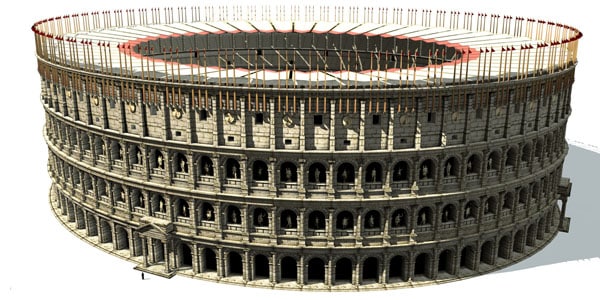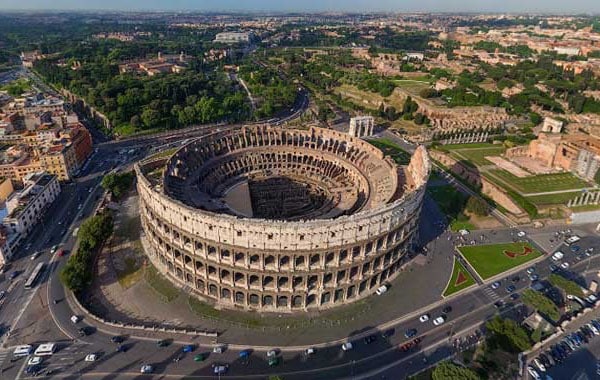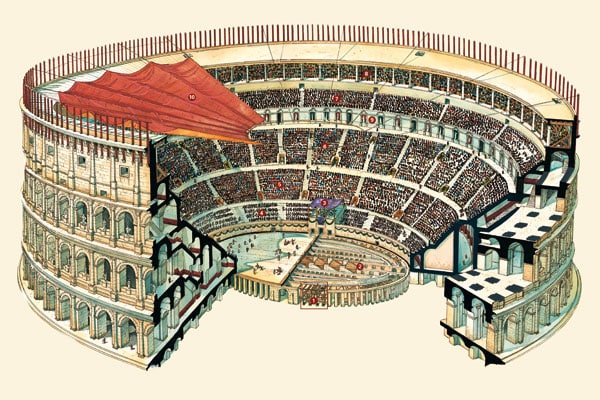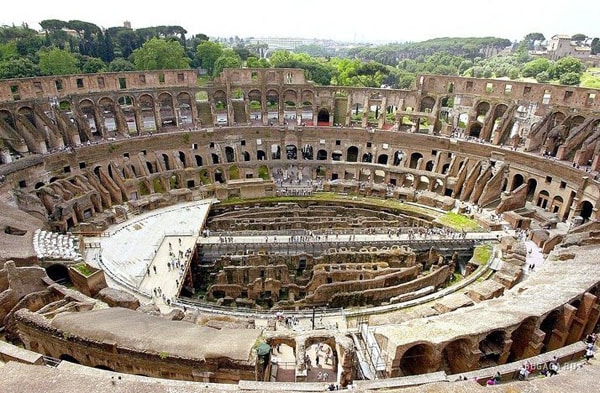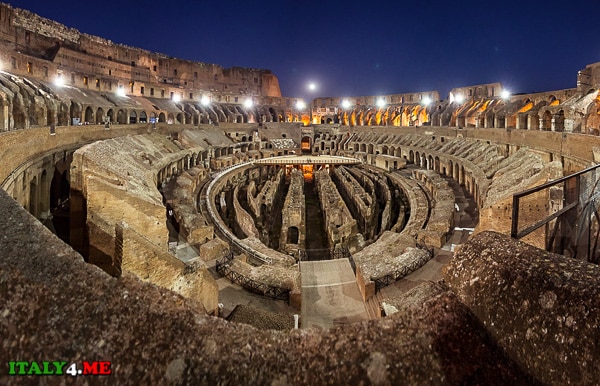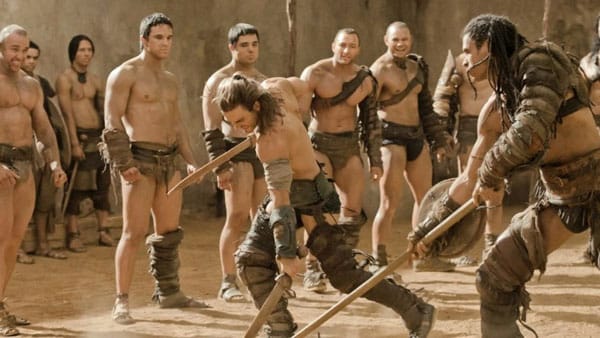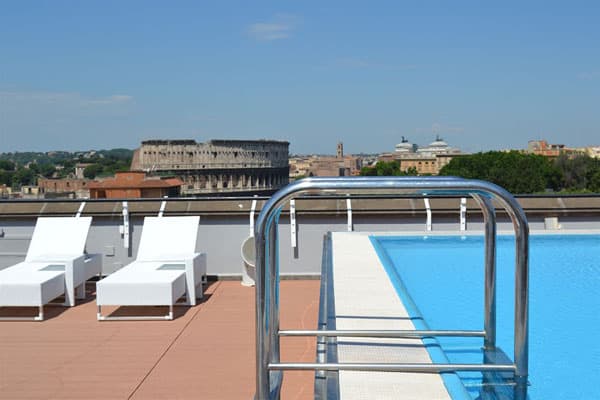Perhaps the history and culture of ancient Rome knew nothing more glorious than the Colosseum, also known as the Amphitheatrum Flavium.
Built during the extensive reconstruction of Rome, the Colosseo has been the most prestigious place of entertainment for residents of the capital and the empire for four centuries. The colossal arena on which captive soldiers and slaves displayed their martial prowess has, over time, become a trademark of Rome.
Page Contents
History
It is interesting to note that the idea to build such a colossal structure came from Emperor Vespasian (Titus Flavius Vespasianus) against the background of his predecessor’s architectural excesses. Emperor Nero (Nero Clavdius Caesar), deposed in 68 AD, left behind an obscenely luxurious Golden Palace (“Golden House” of Nero (Domus Aurea)) and a number of no less expensive buildings. It took Vespasian and his companions several years to restore order to the imperial lands and fill the coffers devastated by the reckless Nero.
Building
In addition to the affairs of the state, the new emperor did not lose sight of the needs of the Romans for cultural entertainment.
Vespasian ordered the vast garden, with a pond in the capital, to be transformed into a new center of social life, a theater. The beginning of the construction work is considered to be the end of 71 – beginning of 72 AD. The flat area between Rome’s three hills, the Celio, the Esquilino, and the Palatino, was ideal for the purpose.
This massive undertaking would have required an enormous expenditure of human resources and money. However, the recent war with the Jews had provided Vespasian with over 100,000 captive slaves and the necessary funds. The captives worked to extract travertine and building stone 20 miles from Rome near Tivoli and toiled hard to bring the materials to the capital.
The theater was erected at the eastern end of the Roman Forum by AD 80. By this point, Emperor Vespasian had died, passing the reins to his son, Titus Flavius Vespasianus. The successor not only built the Colosseum in Rome but celebrated its completion with a lavish ceremony and consecrated it with his family name, the Flavius Amphitheatre.
Capacity and repertoire of Antic Colosseum
The building held between 50,000 and 80,000 spectators, with an average of 65,000 visitors. “Its repertoire included gladiatorial fights, sea battles, battles involving wild animals, executions, a reenactment of historical battles, and even theatrical performances based on ancient myths.
Early Ages
The Colosseum quickly became a place of interest, so Titus, his brother Domitianus (lat. Titus Flavius Domitianus), and subsequent emperors of Rome were regularly engaged in improving the structure.
In the 3rd century AD, the amphitheater was too severely damaged by fire, so Alexander the North (Marcus Aurelius Severus Alexandrus) restored the structure.
In the 5th century AD, the great Rome renounced the Pantheon of pagan gods to finally convert to Christianity. Immediately, Emperor Honorius Augustus (Latin: Flavius Honorius Augustus) issued a ban on gladiatorial fights contrary to the new religion’s commandments. However, the Colosseum retained its status as an entertainment venue, offering spectators the torture of wild animals. In the 5th century, Italy fell under the domination of the Visigoths, which led to the gradual destruction of the Flavian amphitheater.
Middle Ages
At the end of the 6th century, a small sanctuary was built inside the Colosseum, the arena began to serve as a cemetery, and the niches and arches of the amphitheater housed shops and workshops.
In 1200, the aristocratic Frangipane family took full possession of the building and began to fortify it.
In the mid-14th century, Rome was shaken by a massive earthquake that caused the southern outer wall of the Colosseum to collapse. The building that had begun to crumble was actively used to construct medieval churches, castles, villas, and hospitals. Medieval architects were exceedingly zealous in breaking out the bronze masonry partitions. Without additional reinforcement, the walls of the giant arena began to crumble many times over.
Modern times
Beginning in the 16th century, the church gained significant influence over the Colosseum. Pope Sixtus V planned to build a wool processing plant there. And in the 17th century, a new entertainment appeared in the amphitheater: bullfighting. In the middle of the 18th century, Pope Benedict XIV proclaimed the Colosseum a sacred site for the Catholic Church, an early Christian shrine.
Subsequently, the pontificate made repeated attempts to restore the historical monument. During the XIX century, extensive work was carried out to excavate the amphitheater arena and strengthen the damaged facade. The structures acquired their present appearance during the reign of Benito Mussolini, the Duce of Mussolini.
Roman Colosseum Today
Today the Colosseum has become one of the most famous landmarks of Rome. Every day thousands of tourists visit the ancient Roman amphitheater and its surroundings, and the annual flow of visitors is several million.
Tip: To enjoy the Colosseum’s splendor, you can meet the dawn during an extraordinary individual excursion of the team GID.ITALY4.ME – we sincerely recommend falling in love with Rome in the right company.
Structure of the Colosseum
The appearance of the Colosseum has been borrowed from the theatres typical of late Roman times.
In plan, the amphitheater is elliptical in size: 189 m by 156 m, with a base area of about 24,000 m2. The height of the outer wall was 48-50 m, and the perimeter was 545 m. The arena itself is an oval with a width of 55 m and a length of 87 m. From the spectators, the arena was fenced with a wall five meters high.
Appearance
It took about 100,000 m3 of travertine to build the outer wall. The stones, laid without cement, were bolted together with metal piles, weighing 300 tons in total. The past centuries and a major earthquake had robbed the Colosseum of its former luster. Only the northern segment was left. The rest dispersed to building materials for the medieval inhabitants of Rome. And only in the 19th century, the authorities decided to restore the Colosseum.
The surviving part of the theatre is three tiers of arches, one on top of the other. The whole construction is crowned by the attic, decorated with pilasters of the Corinthian order. In the times of Ancient Rome, each arch of the second and the third tier was surrounded by a statue, representing one of the divine patrons of the Latins.
Inside the original version of the Roman Colosseum
The architects of antiquity had the difficult task of granting easy access to visitors. 80 entrances were built on the underground floor of the building. Seventy-six were intended for ordinary people – the remaining four were for nobles. The main northern entrance was reserved for the emperor and his entourage. The four “elite” gates were decorated in artificial marble and differed favorably from the standard portals.
To visit the amphitheater, the ancient spectators bought tickets on which their row and seat number were engraved. Visitors could get to their seats through passageways under the tribunes. The vomitorium was also used as emergency exit.
According to historical records from the 4th century AD, the capacity of the Colosseum was 87 thousand spectators. The visitors were seated according to their social status. Separate boxes were provided for the emperor and the vestal virgins to the north and south of the Colosseum, respectively. These boxes offered the best view of the arena.
Slightly higher were the boxes of the nobility, the seats were personalized and engraved with their names. Still higher were the tribunes of the Roman warriors – the maenianum primum. The next level, the maenianum secundum, was for the wealthy Romans, followed by seats for ordinary people. Another category of seats was for different citizens: boys with teachers, soldiers on leave, foreign guests, priests, etc.
In the time of Domitian, a gallery was added on the roof of the Colosseum. Since then, slaves, women, and the poorest spectators could visit performances. It was supposed to be all standing room only.
The arena
The arena was based on a dense wooden platform 83 by 43 meters, generously sanded on top – the Latin word for “harena.”
This planking is concealed underneath a deep dungeon called the hypogeum. Today little remains of the original Roman arena, but the hypogeum can be seen in detail. It consists of a system of two-level tunnels and cages located under the arena. This is where gladiators and wild animals were kept before they came out to battle.
Eighty vertical elevators lifted animals, including elephants. Such complicated mechanisms required constant repair and renewal. The hypogeum was connected by a chain of underground tunnels and had passages outside it. Warriors and animals were brought to the place of performance from nearby barracks and cowsheds. There was also a certain passage in the dungeon for the needs of the emperor and the vestals.
Many mechanisms of various types were located in the dungeon. For example, the forerunners of elevators and structures that opened the cages of particularly dangerous predators. Researchers have also discovered the remains of an ancient hydraulic system that allowed the entire arena to be lowered or raised quickly!
Several auxiliary institutions were close to the Colosseum. The Ludus Magnus (“Great Polygon”), known as the Gladiator School. One of the 4 great gladiatorial schools delivered warriors to the rally ground by means of a unique underground tunnel. There was also the Ludus Matutinus school nearby. Here warriors trained, who specialized in battles with animals.
Interesting facts about the Roman Colosseum
The interior of the Colosseum in Rome has suffered dramatically over time. Now, 1,500 seats remained. Nevertheless, some world-renowned stars prefer this particular venue for their performances: Ray Charles in May 2002, Sir Paul McCartney in May 2003, Elton John in September 2005, and Billy Joel in July 2006.
The image of the Colosseum has been used many times in art: literature, cinema, computer games, and music. The most prominent examples are:
- strategy games: Age of Empires, Civilization, Assassins’ Creed;
- movies: Roman Holiday (1953), Gladiator (2000);
- songs: Bob Dylan’s Bob Dylan – “When I Paint My Masterpiece” and the Russian rock band Aria – “Colosseum.”
Hotel with a view of the Colosseum
The closest hotel to the Colosseum is the Mercure Roma Centro Colosseo hotel.
4-star hotel, renovated in 2013, offers its guests comfortable rooms, considering their personal preferences (rooms for smokers, non-smokers, children, and people with disabilities). The terrace overlooks Rome and the Flavio Amphitheatre. The swimming pool on the roof is an excellent addition to it!
- Address: Via Labicana 144
- Price per room: 150 Euros.
- Web site: www.booking.com
Tickets – How to Visit the Colosseum?
A full ticket to enter the Colosseum costs a minimum of 18 EUR. The price includes entrance to Palatine Hill and the Roman Forum. The ticket is valid for 48 hours – one time for each attraction. Reservations cost an additional 2 EUR.
A discount ticket costs 7.5 EUR and is valid for EU citizens ages 18 to 25.
Tourists under 18 can get free tickets at the ticket office, provided the parents have a reservation.
Read detailed instructions for purchasing tickets to the Colosseum.
Opening hours of the Colosseum in Rome?
Opening hours:
- from 8:30 a.m. to sundown:
- 8:30 a.m. to 4:30 p.m. – 2 January 2 until 15 February;
- 8:30 to 5:00 p.m. – 16 February until 15 March;
- 8:30 a.m. to 5:30 p.m. – 16 March until the last Saturday in March;
- 8:30 a.m. to 7:15 p.m. – last Saturday in March until 31 August;
- 8:30 a.m. to 7:00 p.m. – during September;
- 8:30 a.m. to 6:30 p.m. – 1st to the last Sunday in October;
- 8:30 to 16:30 – the last Sunday in October until December 31.
How to get to the Colosseum
The Colosseum is located in the historic center of Rome, near the Roman Forum and Piazza Venezia. See a step-by-step guide to reach any Roman tourist attraction.
- Address: Piazza del Colosseo
- Metro: line B (Colosseo station), line A (Manzoni), and then take tram No. 3.
- Buses: No. 60, 75, 85, 87, 271, 571, 175, 186, 810, C3, and e-minibus No. 117.
- Tram: No.3.
 Italy for me From Italy with love
Italy for me From Italy with love


